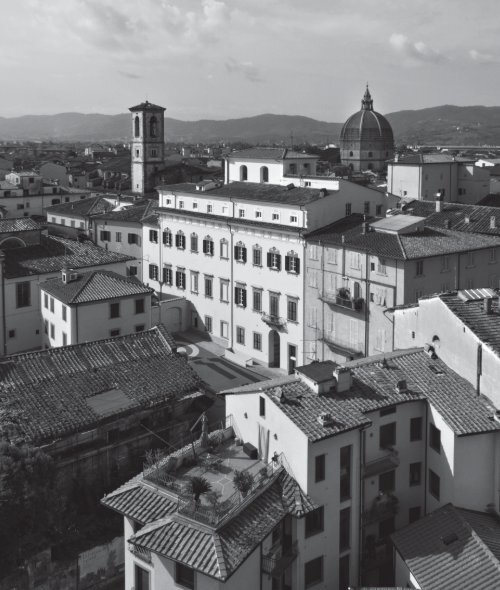Palazzo de'Rossi. Una storia pistoiese
a cura di Roberto Cadonici fotografie di Aurelio Amendola
a cura di Roberto Cadonici
fotografie di Aurelio Amendola
Create successful ePaper yourself
Turn your PDF publications into a flip-book with our unique Google optimized e-Paper software.
UN PALAZZO NELLA CITTÀ<br />
LA NOBILE DIMORA DEI ROSSI E LE SUE VICENDE<br />
Lucia Gai<br />
L’importanza di un mito<br />
Costretta entro l’angusta prospettiva di una stretta via medioevale del centro di Pistoia,<br />
la facciata del settecentesco palazzo de’ Rossi 1 , impossibile da cogliere frontalmente e<br />
con un solo sguardo, pare un controsenso architettonico (figg. 1, 2).<br />
Sicuramente, almeno secondo i criteri con cui si sceglieva l’ubicazione delle residenze patrizie<br />
dal Quattrocento e per tutta l’età moderna, il palazzo non godeva di una posizione urbana<br />
particolarmente felice, non si affacciava su una piazza, su una via spaziosa, neppure su<br />
uno slargo che consentisse di apprezzarne, emergendo entro il fitto tessuto edilizio di una<br />
città d’impianto medioevale come Pistoia, l’articolazione strutturale, volumetrica e decorativa<br />
cui era affidato il compito di farsi metafora della fortuna e dell’importanza del casato.<br />
La posizione entro la città era infatti segno, di per sé, della ‘posizione’ sociale, dell’influenza<br />
e della ricchezza della famiglia. L’immagine, la percezione ottica stessa, nei secoli<br />
del “vedutismo”, si traduceva nell’opinione pubblica locale in capacità di permanente<br />
‘presenza’.<br />
Per la verità, Pistoia non offriva molte possibilità, in questo senso. Come aveva a riferire<br />
al granduca il commissario Giovan Battista Tedaldi nel 1570 2 , Pistoia non era città di<br />
piazze, di monumenti e fontane; non comprendeva quegli spazi aperti, quell’“agio” – consueto<br />
alla capitale di Toscana – che consentivano di fissare per sempre, nell’immaginario<br />
collettivo e nei ricordi dei protagonisti del turismo d’arte, città come Venezia, Firenze,<br />
Roma, Napoli e altre.<br />
Tuttavia, fra Sei e Settecento, a Pistoia i palazzi patrizi, come quelli dei Fabroni, dei Mar-<br />
A PALAZZO IN THE CITY<br />
THE NOBLE RESIDENCE OF THE ROSSI FAMILY AND ITS HISTORY<br />
Lucia Gai<br />
1. Pistoia, prospettiva dal Canto dei Rossi verso Via dei Rossi.<br />
The Importance of a Myth<br />
Squeezed into the cramped confines of a narrow medieval street in the center of Pistoia,<br />
the façade of the 18 th -century <strong>Palazzo</strong> de’ Rossi, 1 impossible to take in at a glance from<br />
the front, seems to be an architectural absurdity (figs. 1, 2).<br />
Certainly, at least according to the criteria by which the location of aristocratic residences<br />
was chosen from the 15th century onward and throughout the modern era, the building was<br />
not in a particularly happy position. It did not face onto a square, a broad street or any kind<br />
of open space that would make it possible to appreciate, amidst the dense urban fabric of a<br />
city with a medieval layout like Pistoia, the structural articulation, disposition of masses and<br />
decoration that were supposed to be an expression of the family’s wealth and importance.<br />
The position in the city was in fact a mark, in and of itself, of that family’s social “position,”<br />
of its influence and affluence. The image, the actual visual perception of the building,<br />
in the centuries of vedutismo, was translated in local public opinion into a capacity for<br />
permanent “presence.”<br />
To tell the truth, Pistoia did not offer many possibilities in this regard. As the<br />
commissioner Giovan Battista Tedaldi had told the grand duke in 1570, 2 Pistoia was not<br />
a city of squares, monuments and fountains; it did not have those open spaces, those<br />
“gaps”—customary in the capital of Tuscany—which fixed cities like Venice, Florence,<br />
Rome, Naples and others forever in the collective imagination and in the memories of<br />
tourists drawn by the cultural treasures of Italy.<br />
And yet, between the 17th and 18th century, the aristocratic residences of Pistoia, like<br />
2. Prospettiva della facciata del palazzo.<br />
30 31














